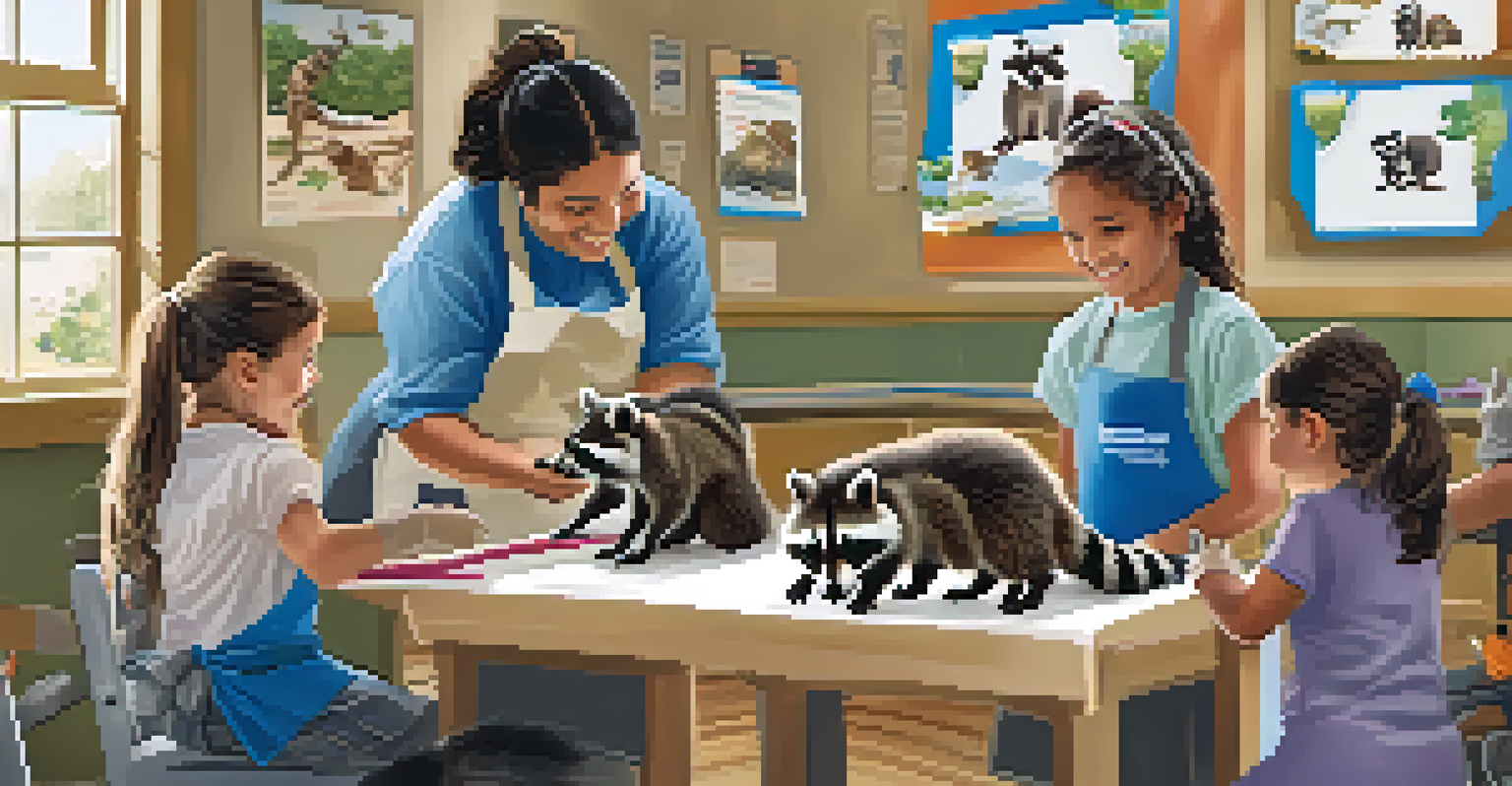Local Wildlife Rehabilitation Centers and Their Impact

Understanding Wildlife Rehabilitation Centers
Wildlife rehabilitation centers are specialized facilities that care for injured, orphaned, or sick animals with the goal of returning them to their natural habitat. These centers often operate with a deep commitment to animal welfare, providing medical treatment, nutrition, and a safe environment for recovery. By focusing on rehabilitation rather than captivity, they play a crucial role in preserving local wildlife populations.
The greatness of a nation and its moral progress can be judged by the way its animals are treated.
These centers typically rely on a combination of licensed professionals and dedicated volunteers, who bring a range of skills and knowledge. For instance, a veterinarian might treat a bird with a broken wing, while volunteers help with feeding and cleaning. This collaborative approach not only enhances the care animals receive but also strengthens community ties as people come together for a common cause.
Moreover, rehabilitation centers often serve as educational resources, raising awareness about local wildlife and conservation issues. They provide opportunities for the public to learn about the importance of protecting natural habitats and the challenges faced by various species, fostering a sense of responsibility and connection to the environment.
The Impact on Local Wildlife Populations
Rehabilitation centers significantly contribute to the recovery of local wildlife populations by providing medical care and rehabilitation services. When animals are injured or orphaned, these facilities step in to offer the necessary support, ensuring that they can eventually be released back into the wild. This not only helps individual animals but also strengthens the overall health of ecosystems.

For example, a center that rehabilitates raptors might see a steady stream of injured hawks or owls, which, once treated, can return to their roles as hunters in the food chain. By maintaining balanced ecosystems, these centers indirectly support biodiversity, which is crucial for the resilience of our natural world.
Role of Rehabilitation Centers
Wildlife rehabilitation centers care for injured and orphaned animals, aiming to prepare them for release back into their natural habitats.
Additionally, successful rehabilitation efforts can lead to increased public awareness about the importance of wildlife conservation. When communities witness the release of a rehabilitated animal, it often sparks conversations about local wildlife and encourages individuals to take action to protect their natural surroundings.
Community Involvement and Support
Local wildlife rehabilitation centers thrive on community support, whether through donations, volunteer work, or educational outreach. Many centers host events, workshops, and programs that invite community members to learn about wildlife care and conservation. These initiatives not only provide valuable resources for the centers but also create a sense of ownership and pride within the community.
Wildlife and humans cannot coexist without the understanding of their interdependence.
Volunteers play a pivotal role in the daily operations of wildlife rehabilitation centers. From feeding and cleaning to administrative tasks, their contributions help ensure that animals receive the best possible care. In many cases, these volunteers become passionate advocates for wildlife, spreading awareness and encouraging others to get involved.
Moreover, local businesses often step up to support these centers, whether through financial donations, in-kind services, or sponsorship of events. This collaboration strengthens community ties and highlights the shared commitment to preserving local wildlife and habitats.
Educational Programs and Outreach Efforts
Educational programs offered by wildlife rehabilitation centers play a vital role in fostering awareness and understanding of local ecosystems. These programs often include school visits, workshops, and community events, where attendees can learn about wildlife care, conservation issues, and the importance of protecting natural habitats. By making these topics accessible, centers empower individuals to take action.
Hands-on experiences, such as guided tours or volunteer opportunities, also enhance learning and engagement. For instance, children who participate in a wildlife care workshop may develop a lifelong interest in conservation. This education is crucial, as it cultivates the next generation of wildlife advocates and environmental stewards.
Community Engagement is Key
Community involvement through donations and volunteering strengthens wildlife rehabilitation centers and fosters local pride in conservation efforts.
Furthermore, outreach efforts can extend to social media and online platforms, allowing centers to reach a wider audience. Through informative posts, videos, and live streams, they can share success stories of rehabilitated animals, inspiring more people to get involved in wildlife protection and conservation efforts.
Challenges Faced by Wildlife Rehabilitation Centers
Despite their critical importance, wildlife rehabilitation centers face numerous challenges that can hinder their operations. Limited funding is a common issue, as many rely on donations and grants to cover costs related to animal care, facility maintenance, and staffing. Without adequate financial support, centers may struggle to provide the necessary resources for the animals they serve.
Additionally, the increasing number of wildlife emergencies due to habitat destruction, pollution, and climate change places added pressure on these facilities. As more animals require assistance, centers must find ways to expand their capabilities while maintaining high standards of care. This often means seeking additional volunteers and resources, which can be a daunting task.
Moreover, regulatory hurdles can complicate the work of rehabilitation centers. Navigating legal requirements for wildlife care and permits can be time-consuming and challenging, especially for smaller organizations. These obstacles can divert valuable time and energy away from their primary mission of helping injured and orphaned animals.
The Role of Technology in Rehabilitation
Technology has become an invaluable tool for wildlife rehabilitation centers, enhancing their ability to care for animals and streamline operations. From medical equipment to software for tracking animal health records, advancements in technology have made it easier to provide top-notch care. For example, digital imaging can help veterinarians diagnose issues more accurately and efficiently.
Furthermore, social media and online fundraising platforms have revolutionized how centers connect with the community and raise funds. By sharing their stories and successes online, rehabilitation centers can reach a broader audience, encouraging more people to support their mission. This increased visibility can lead to higher donation levels and greater community involvement.
Education Drives Conservation
Educational programs offered by these centers raise awareness about wildlife conservation, inspiring individuals to protect natural habitats.
Additionally, educational technologies such as virtual reality and interactive online platforms can enhance outreach efforts. By using these tools, centers can create immersive experiences that educate the public about wildlife conservation and the importance of rehabilitation, ultimately inspiring more people to get involved.
Success Stories: Animals Rehabilitated and Released
One of the most rewarding aspects of wildlife rehabilitation centers is witnessing the successful recovery and release of animals. Stories of individual animals overcoming adversity can inspire hope and highlight the incredible work being done. For instance, a center might share the journey of a young fawn that was orphaned after a car accident and later released back into its natural habitat, symbolizing resilience and the power of care.
These success stories not only showcase the dedication of wildlife rehabilitators but also serve as powerful reminders of the importance of conservation efforts. When communities see the tangible results of rehabilitation work, it fosters a greater appreciation for wildlife and motivates individuals to support these vital organizations.

Moreover, sharing these stories on social media and through community events can engage more people in the cause. By highlighting the impact of rehabilitation, centers can encourage others to volunteer, donate, or advocate for wildlife conservation, creating a ripple effect that benefits local ecosystems.